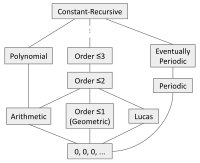Constant-recursive sequence

Imagine you have a big box of toys, and you want to play with them every day. You decide to make a rule: every day, you'll take out half of the toys you played with yesterday and add one more new toy. Then, you repeat this rule every day: take out half the toys, add one more new toy.
This is what a constant-recursive sequence is! It's a rule you create that tells you how to find each new number in a sequence by using the previous numbers. In this case, we start with a certain number, and we apply the same rule to it over and over again, generating more numbers.
So, let's say you start with 4 toys. You apply the rule: take out half of the toys (4/2=2), and add one more new toy (2+1=3). So, the next day, you have 3 toys. You apply the rule again: take out half the toys (3/2=1.5, but since we can't have half a toy, we round down to 1), and add one more new toy (1+1=2). So, the next day, you have 2 toys. You apply the rule again: take out half the toys (2/2=1), and add one more new toy (1+1=2). So, the next day, you have 2 toys again.
Can you see how the sequence of toys is generated by this constant-recursive rule? It's the same rule being applied over and over again, generating more numbers. In this case, we call it a constant-recursive sequence because the rule is always the same: take out half the toys and add one more new toy.
This is what a constant-recursive sequence is! It's a rule you create that tells you how to find each new number in a sequence by using the previous numbers. In this case, we start with a certain number, and we apply the same rule to it over and over again, generating more numbers.
So, let's say you start with 4 toys. You apply the rule: take out half of the toys (4/2=2), and add one more new toy (2+1=3). So, the next day, you have 3 toys. You apply the rule again: take out half the toys (3/2=1.5, but since we can't have half a toy, we round down to 1), and add one more new toy (1+1=2). So, the next day, you have 2 toys. You apply the rule again: take out half the toys (2/2=1), and add one more new toy (1+1=2). So, the next day, you have 2 toys again.
Can you see how the sequence of toys is generated by this constant-recursive rule? It's the same rule being applied over and over again, generating more numbers. In this case, we call it a constant-recursive sequence because the rule is always the same: take out half the toys and add one more new toy.
